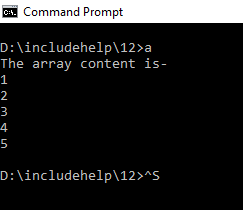C 中的 fread() 函数
原型:
size_t fread(void *buffer, size_t length, size_t count, FILE *filename);
参数:
void *buffer, size_t length, size_t count, FILE *filename
返回类型:size_t
函数的使用:
函数 fread() 的原型为:
size_t fread(void *buffer, size_t length, size_t count, FILE *filename);
在文件处理中,通过fread()函数,我们读取count大小对象的数量length从输入流filename到名为的数组buffer.它返回从文件中读取的对象数。如果读取的对象较少,或者EOF在此之前遇到它会报错。
C 中的 fread() 示例
#include <stdio.h>
#include <stdlib.h>
int main()
{
FILE* f;
//initialize the arr1 with values
int arr1[5] = { 1, 2, 3, 4, 5 };
int arr2[5];
int i = 0;
//open the file for write operation
if ((f = fopen("includehelp.txt", "w")) == NULL) {
//if the file does not exist print the string
printf("Cannot open the file...");
exit(1);
}
//write the values on the file
if ((fwrite(arr1, sizeof(int), 5, f)) != 5) {
printf("File write error....\n");
}
//close the file
fclose(f);
//open the file for read operation
if ((f = fopen("includehelp.txt", "r")) == NULL) {
//if the file does not exist print the string
printf("Cannot open the file...");
exit(1);
}
//read the values from the file and store it into the array
if ((fread(arr2, sizeof(int), 5, f)) != 5) {
printf("File write error....\n");
}
fclose(f);
printf("The array content is-\n");
for (i = 0; i < 5; i++) {
printf("%d\n", arr2[i]);
}
return 0;
}输出

相关用法
- C语言 freopen()用法及代码示例
- C语言 frexp()用法及代码示例
- C语言 feof()用法及代码示例
- C语言 fillellipse()用法及代码示例
- C语言 fgets()用法及代码示例
- C语言 fclose()用法及代码示例
- C语言 fseek() vs rewind()用法及代码示例
- C语言 fflush()用法及代码示例
- C语言 fgetc()用法及代码示例
- C语言 fputc()用法及代码示例
- C语言 fputs()用法及代码示例
- C语言 fillpoly()用法及代码示例
- C语言 ftell()用法及代码示例
- C语言 fseek()用法及代码示例
- C语言 fgets() and gets()用法及代码示例
- C语言 fscanf()用法及代码示例
- C语言 ferror()用法及代码示例
- C语言 fgetc() and fputc()用法及代码示例
- C语言 fwrite()用法及代码示例
- C语言 fork()用法及代码示例
注:本文由纯净天空筛选整理自Souvik Saha大神的英文原创作品 fread() function in C language with Example。非经特殊声明,原始代码版权归原作者所有,本译文未经允许或授权,请勿转载或复制。
